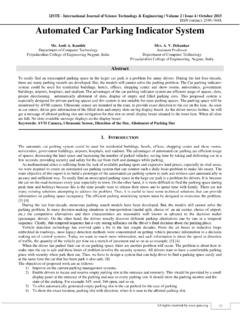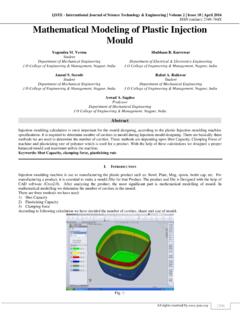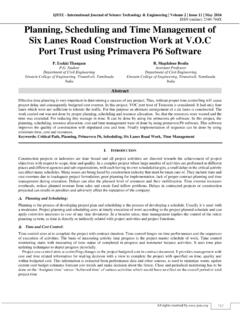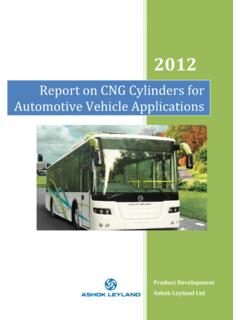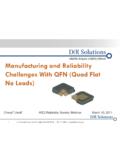Transcription of Design and Analysis of Diaphragm Spring of a …
1 IJSTE - International Journal of Science Technology & Engineering | Volume 2 | Issue 12 | June 2016 ISSN (online): 2349-784X All rights reserved by 26 Design and Analysis of Diaphragm Spring of a Single Plate Dry Clutch Abhijit Rupnar Aditya Babar UG Student UG Student Department of Mechanical Engineering Department of Mechanical Engineering Smt. Kashibai Navale College of Engineering, Pune Smt. Kashibai Navale College of Engineering, Pune Akash Karale Sanket Gundawar UG Student UG Student Department of Mechanical Engineering Department of Mechanical Engineering Smt. Kashibai Navale College of Engineering, Pune Smt. Kashibai Navale College of Engineering, Pune Abstract A Clutch is a machine element used to connect a driving shaft to the driven shaft, so that the driven shaft can be given power or stopped at wheel, without stopping the driving shaft. Clutches are designed for the transfer of maximum torque from the engine with minimum heat generation. During engagement and disengagement the two clutch discs have an axial sliding motion between them.
2 The clutch is allowed to engage the transmission system gradually only with a certain amount of slippage between the flywheel and the pressure plate. The paper contains the designing and Analysis of Diaphragm Spring used for the generation of clamping load. The Design of single plate clutch is done for Force Motors New Vehicle and is drawn by using theoretical calculation results. For designing of the Diaphragm Spring , 3d modelling software used is CATIA Structural Analysis is done to find the stress distribution on the model. With the Analysis results, we check whether the Design is safe or not, comparing the result with theoretical calculation and theoretical results. For structural Analysis HYPERMESH software is used. Keywords: Clutch Clamp Load, Diaphragm Spring , Dry Clutch, Single Plate Clutch _____ I. INTRODUCTION In clutch cover assembly, the Diaphragm Spring is installed between the pressure plate and the cover stamping, or cover casting.
3 The Diaphragm Spring contracts the cover stamping (or cover fulcrum elements) and pressure plate at specific fulcrum diameters. In this configuration the Diaphragm Spring creates a clamping load through the pressure plate fulcrum and provides a lever ratio B/A, through which a release load R can be applied to disengage the clutch (clamp load). Clamp load and release load are related through the lever ratio, as are pressure plate travel and release bearing travel. Understanding these load and travel relationships will form the basis for understanding the basic functioning of the Diaphragm Spring clutch. The release bearing contacts the Diaphragm Spring levers at a specified contact diameter. The pressure plate contacts the Diaphragm Spring at a specified fulcrum diameter. The force of the Diaphragm Spring (clamp load) is transferred through the pressure plate at his point, known as the pressure plate fulcrum. This point is also sometimes called the cam, because of the motion of Diaphragm Spring over this area.
4 The pressure pate stays in contact with the Diaphragm Spring through the force of clutch cover drive straps, or by clips which physically hold the Diaphragm Spring to the pressure plate II. FUNCTION OF Diaphragm Spring The clamping force on the friction facings is provided by the Diaphragm Spring . The Diaphragm Spring is a steel disc having a hole at the center, and the inner portion of the disc is radially slotted so that a number of actuating (release-lever) fingers are formed. The outer ends of the slots are provided with enlarged blunting holes, which distribute the concentrated stresses created during deflection of the fingers, and also provide a means of locating the shouldered rivets, which restrain the fulcrum rings. Unloaded, it is a dished shape. As the pressure plate cover tightens, it pivots on its fulcrum rings, and flattens out to exert a force on the pressure plate, and the facings. The transmission input shaft passes through the center of the pressure plate.
5 Its parallel splines engage with the internal splines of the central hub, on the friction disc. With engine rotation, torque can now be transmitted from the flywheel, through the friction disc, to the central hub, and to the transmission. When the clutch pedal is depressed, the movement is transferred through the operating mechanism, to the operating fork and the release bearing. The release bearing moves forward and pushes the center of the Diaphragm Spring towards the flywheel. The Diaphragm pivots on its fulcrum rings causing the outer edge to move in the opposite direction and act on the pressure-plate retraction clips. The pressure plate disengages, and drive is no longer transmitted. Releasing the pedal allows the Diaphragm to re-apply its clamping force and engage the clutch, and drive is restored. Design and Analysis of Diaphragm Spring of a Single Plate Dry Clutch (IJSTE/ Volume 2 / Issue 12 / 007) All rights reserved by 27 III.
6 CLAMP LOAD CALCULATION The axial force required for transmitting the torque is known as the Clamp load. An estimation of the axial force can be computed by means of the following analytical approach. Considering an annular surface for the friction disk with inner radius ri and external radius r0, the axial force F and the transmitted torque T can be computed as function of the normal pressure p on the disk. The hypothesis of constant pressure is usually valid for new clutches, while the hypothesis of constant wear is valid for worn clutches. Under the hypothesis of constant pressure, the axial force can be computed as F = 3T2k (ro2 ri2)(ro3 ri3) .. (1) Where, being the friction coefficient, k the number of disk surfaces (k=2 for a clutch with just one disk). With the same symbols and under the hypothesis of constant wear, the axial force can be computed as F = Tk 2ro+ (2) By applying and , the axial force needed to transmit the torque can be computed.
7 Clamp Load calculation, By uniform pressure theory 1) Rmean=23Ro3 Ri3Ro2 Ri2 = 23[1403 8531403 852] = mm 2) Slip Torque = 2 WRmean 320=2 w w = 526 kg Actual w = FOS 526 IV. Design OF DIAPHGRAM Spring A single Diaphragm Spring in the Diaphragm Spring clutch cover replaces a multitude of components from its immediate predecessor, the coil Spring and lever-type clutch cover. This reduced complexity gives the Diaphragm Spring clutch a cost, manufacturing and weight advantage over previous types. Also the Diaphragm Spring s characteristic, shallow cone shape and high loads generated through small displacements make possible a compact package with high torque transmitting capabilities. In the automotive clutch application the Belleville Spring is fabricated with cantilever levers extending radially inward from the inside diameter. This configuration is known as a Diaphragm Spring . De = Outside diameter, mm Di = Inside diameter, mm t = Thickness of individual Spring , mm ho = Free cone height of the unloaded individual Spring , mm lo = Overall height of the individual Spring , mm lo = ho + t F = Spring force, N s = De fle ctio n, mm 1) Actual inner Diameter (Dactual) = Di- (2 S sin ) = mm Design and Analysis of Diaphragm Spring of a Single Plate Dry Clutch (IJSTE/ Volume 2 / Issue 12 / 007) All rights reserved by 28 2) Diametric Ratio ( ) = DaDactual = 3) Ln ( ) = 4) Load at flat condition, Pflat = 3 = kgF 5) Load at flat with fulcrum, Pful = Pflat ( Daf Dif) = kgF 6) stress Calculations K1 = ( 1 )2 1 ( +1 1 2ln( ))= K2 = 1 6ln( ) [( 1)ln ( ) 1] = K3 =1 ln( ) ( 12) = Fig.
8 1: Cross-Section of Diaphragm Spring stress at point OM OM= 3 4E(1 2)StK1 Da2 OM= kgf/mm2 stress at Point I= 4E(1 2)StK1 Da2[K2(ht st)+K3] I= stress at Point.. II= 4E(1 2)StK1 Da2[K2(ht st)+K3] II= stress at point III= 4E(1 2)St K1 Da2[(2K3 K2)(ht st)+K3] III= stress at Point IV IV= 4E(1 2)St K1 Da2[(2K3 K2)(ht st) K3] IV= Safe stress =80% of UTS. 80% of 170 =136 kg/mm2. All stress values are within limit hence Design is safe. Design and Analysis of Diaphragm Spring of a Single Plate Dry Clutch (IJSTE/ Volume 2 / Issue 12 / 007) All rights reserved by 29 Fig. 2: Model of Diaphragm Spring V. FINITE ELEMENT Analysis OF Diaphragm Spring In this work a simple structural Analysis has been done for the designed Diaphragm Spring model. Results are validated to theoretically calculate the deflection, principal stresses on the Inner and Outer surfaces which are induced in the Spring .
9 Outer Diameter of Belleville Spring is 140 mm and height of the Spring is as mm. A constant Force of 900N has been applied on the inner surface of the Spring in one direction. The Analysis is done by imposing boundary conditions such that the Spring could deflect only along other plane. Constraints and Loading Conditions: A constant Force of 900N has been applied on the inner surface of the Spring in one direction. The Analysis is done by imposing boundary conditions such that the Spring could deflect only along other plane Where K1, K2 and K3 are constraints, E= modulus of Elasticity (2*105 MPa) and 1= poisons ratio ( ). The representative stress and deformation contours for principal stresses on inner & outer surface along with the deflection are shown in figure 3 and 4. Design and Analysis of Diaphragm Spring of a Single Plate Dry Clutch (IJSTE/ Volume 2 / Issue 12 / 007) All rights reserved by 30 Fig. 3: stress Analysis Fig. 4: Displacement Analysis From theoretical calculations stress at point OM is kgf/mm2 and from Hypermesh result is 107 kgf/mm2.
10 Both the values of stress are within 10 % of tolerance and stress results from software and theoretical both are under the UTS value of the Spring material and hence Design is safe in stress Analysis . Height of the Spring is mm and here maximum deflection of the Spring in effective area from where clamp load is applied (yellow region) is , both the values are within 10% of tolerance and hence theoretically calculated height is accepted and minor deflection beyond the limit (height of Spring ) is accepted as Spring is elastic body and here it is used for applying load so exceeding value doesn t affect the function of Spring . VI. CONCLUSION Thus, it is concluded that the analytical equations for Belleville springs though estimates the maximum stresses and deflection for certain cases, but finite element Analysis is recommended for accurate estimation of maximum stress and deflection in case of Belleville Spring under given loading condition.



